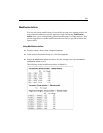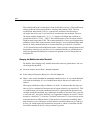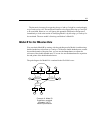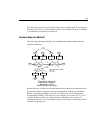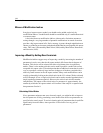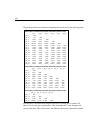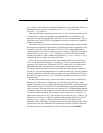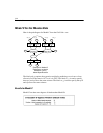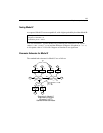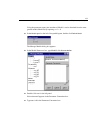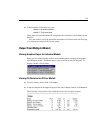
113
Exploratory Analysis
par_1 and par_2 divided by the estimated standard error of this difference. These two
parameters are the regression weights for powles71 <– 71_alienation and
powles67 <– 67_alienation.
Under the distribution assumptions stated on p. 35, the critical ratio statistic can be
evaluated using a table of the standard normal distribution to test whether the two
parameters are equal in the population. Since 0.877 is less in magnitude than 1.96, you
would not reject, at the 0.05 level, the hypothesis that the two regression weights are
equal in the population.
The square of the critical ratio for differences between parameters is approximately
the amount by which the chi-square statistic would increase if the two parameters were
set equal to each other. Since the square of 0.877 is 0.769, modifying Model B to
require that the two regression weights have equal estimates would yield a chi-square
value of about . The degrees of freedom for the new model
would be 6 instead of 5. This would be an improved fit ( versus
for Model B), but we can do much better than that.
Let’s look for the smallest critical ratio. The smallest critical ratio in the table is
0.077, for the parameters labeled par_14 and par_15. These two parameters are the
variances of eps4 and delta1. The square of 0.077 is about 0.006. A modification of
Model B that assumes eps4 and delta1 to have equal variances will result in a
chi-square value that exceeds 6.383 by about 0.006, but with 6 degrees of freedom
instead of 5. The associated probability level would be about 0.381. The only problem
with this modification is that there does not appear to be any justification for it; that is,
there does not appear to be any a priori reason for expecting eps4 and delta1 to have
equal variances.
We have just been discussing a misuse of the table of critical ratios for differences.
However, the table does have a legitimate use in the quick examination of a small
number of hypotheses. As an example of the proper use of the table, consider the fact that
observations on anomia67 and anomia71 were obtained by using the same instrument
on two occasions. The same goes for powles67 and powles71. It is plausible that the tests
would behave the same way on the two occasions. The critical ratios for differences are
consistent with this hypothesis. The variances of eps1 and eps3 (par_11 and par_13)
differ with a critical ratio of –0.51. The variances of eps2 and eps4 (par_12 and par_14)
differ with a critical ratio of 1.00. The weights for the regression of powerlessness on
alienation (par_1 and par_2) differ with a critical ratio of 0.88. None of these
differences, taken individually, is significant at any conventional significance level. This
suggests that it may be worthwhile to investigate more carefully a model in which all
three differences are constrained to be 0. We will call this new model Model C.
6.383 0.769 7.172=+
p 0.307=
p 0.275=



